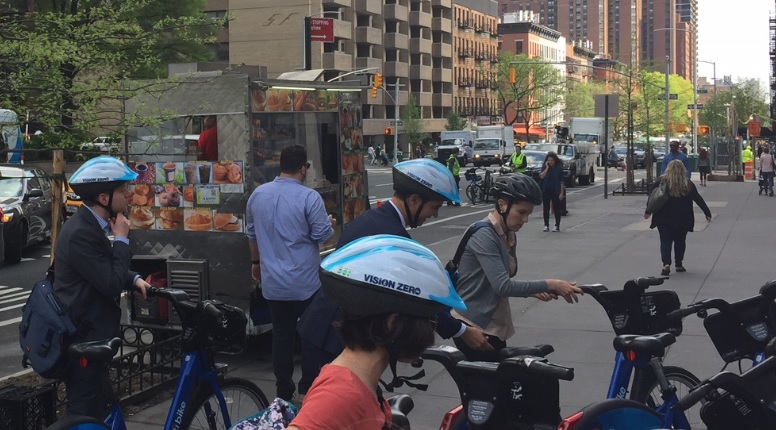Elected officials and advocates gathered with the New York City Department of Transportation on the Upper East Side yesterday to celebrate new transportation improvements in the neighborhood. The first phase of the Second Avenue Subway, crosstown Select Bus Service on 86th Street, Citi Bike’s expansion, and the addition of bike lanes are welcome changes in a neighborhood where until recently there were few options beyond the overcrowded Lexington Avenue Line.
But even in a city where the majority of households are car-free, some people maintain a windshield perspective. CBS New York reporter Emily Smith asked Commissioner Polly Trottenberg “Are you not concerned that by creating all these bike lanes that it’s slowing traffic and making it worse for drivers?”
It’s not just that Smith’s question is wildly out of touch — 84 percent of workers who live on the Upper East Side (the most densely-populated neighborhood in the nation’s most densely-populated county) commute without a car — but it’s also based on a myth.
Fortunately facts are easy enough to find, and they demonstrate that more tourists, more residents, and more vehicles have been coming into the city over the course of the last several years. Eben Weiss, better known as “Bike Snob,” reports at Transportation Alternatives’ Daily Bike Forecast:
Consider that 11 million more tourists visited New York City in 2015 than in 2010:
Tourists:
2010: 48.7 million
2015: 59.7 million
That’s 11 million more people hailing cabs, calling Ubers, and wearing plastic yellow ponchos on the tops of those double-decker sightseeing buses when it rains.
Then consider that between 2010 and now the city has experienced some major population growth:
The U.S. Census Bureau has estimated New York City’s population at 8,537,673, as of July 2016. This represented an increase of 362,500 residents (or 4.4 percent) over the April 2010 decennial census count of 8,175,133. The city has not witnessed such a robust pace of growth in over a half-century.
And perhaps most significantly, there were well over 100,000 more vehicle registrations in force in New York City in 2015 than there were in 2010:
Vehicle Registrations:
2015: 1,879,464
2010: 1,767,091
Luckily not every reporter present at yesterday’s press event was fixated on bike lanes. Andrew Siff with the local NBC affiliate asked Commissioner Trottenberg why she hasn’t told the mayor to “put [his] muscle behind congestion pricing.” Trottenberg replied, “Commissioners don’t give mayors orders. It actually works the other way around.”
True, but of course there’s more to it than that. Politicians traditionally try to avoid raising taxes or tolls in election years; perhaps it’s something Mayor de Blasio would be more inclined to get behind if elected to a second term. And even though a majority of New Yorkers don’t own cars (and an even bigger majority don’t even drive to work), elected officials tend to overestimate how many of their constituents would be impacted by tolls on the East River bridges. And let’s not forget, just as de Blasio doesn’t control the MTA, he also doesn’t get to decide whether bridges will be tolled or not. That’s up to Albany, and as Commissioner Trottenberg put it, “It’s not something that seems there’s appetite for at the state level.”


So how many cyclists are there and do they interfere with transit buses?
[…] and Tri-State Blow Holes in Emily Smith’s Stupid CBS2 […]
@Clark, There’s exponentially more cyclists every year as infrastructure is provided. When you ask “how many”, what do you mean? Like, percent of travelers on a specific route at a specific time? In total in NYC?
Do they interfere with transit buses? Substantially less than automobiles do. In what context do you ask this? Like, do they cause a problem for buses getting along through the city? I think short answer is, largely, no.
The bike lines on Staten Island are a waste of road space. No one uses them. Bicycling is great exercise but not a way for a sane person to commute into Manhattan.
Is there anywhere in this whole wide world where a majority of the people own cars?
Why do you continue to use this silly assertion about little old NYC?
Car counters everywhere use motor vehicles per household, why can’t you hold to the same measure. It’s still not a majority but it is more illustrative of the relevant comparison.
What’s wrong with you?